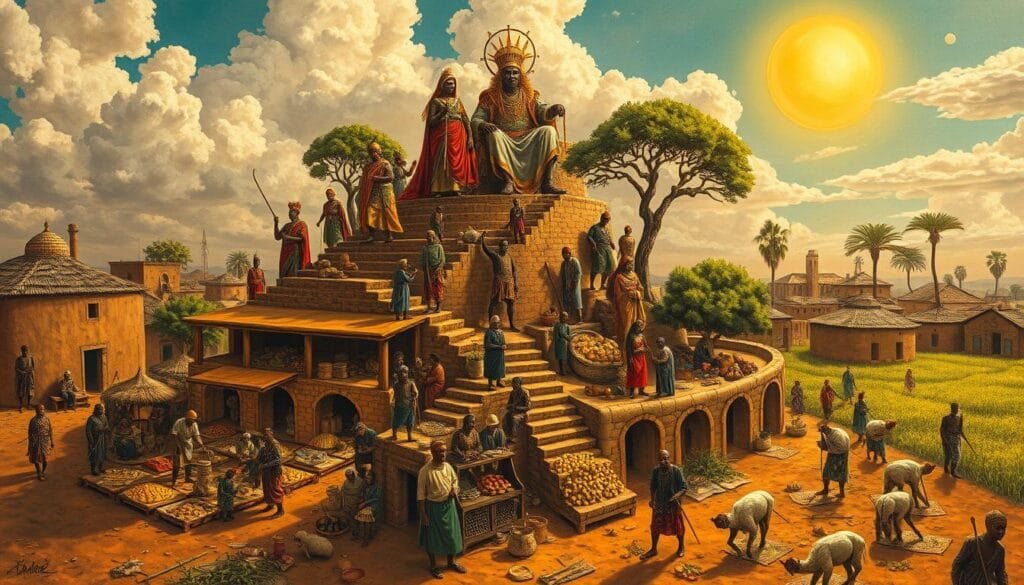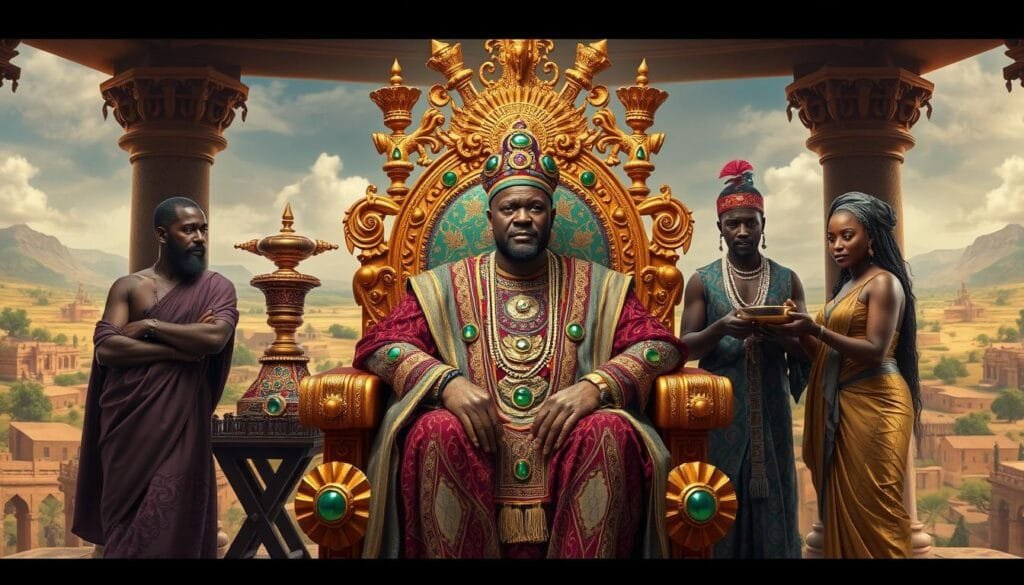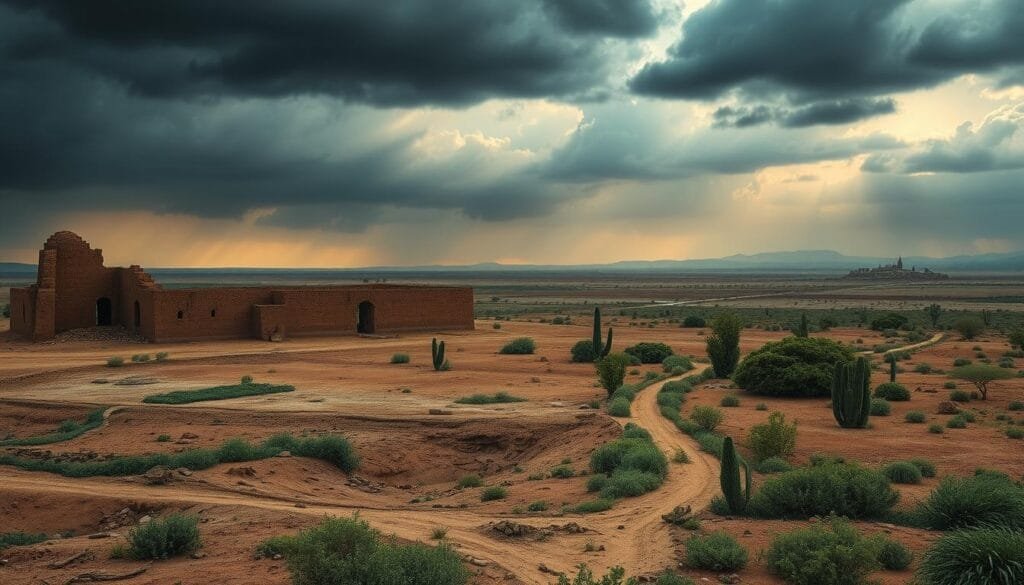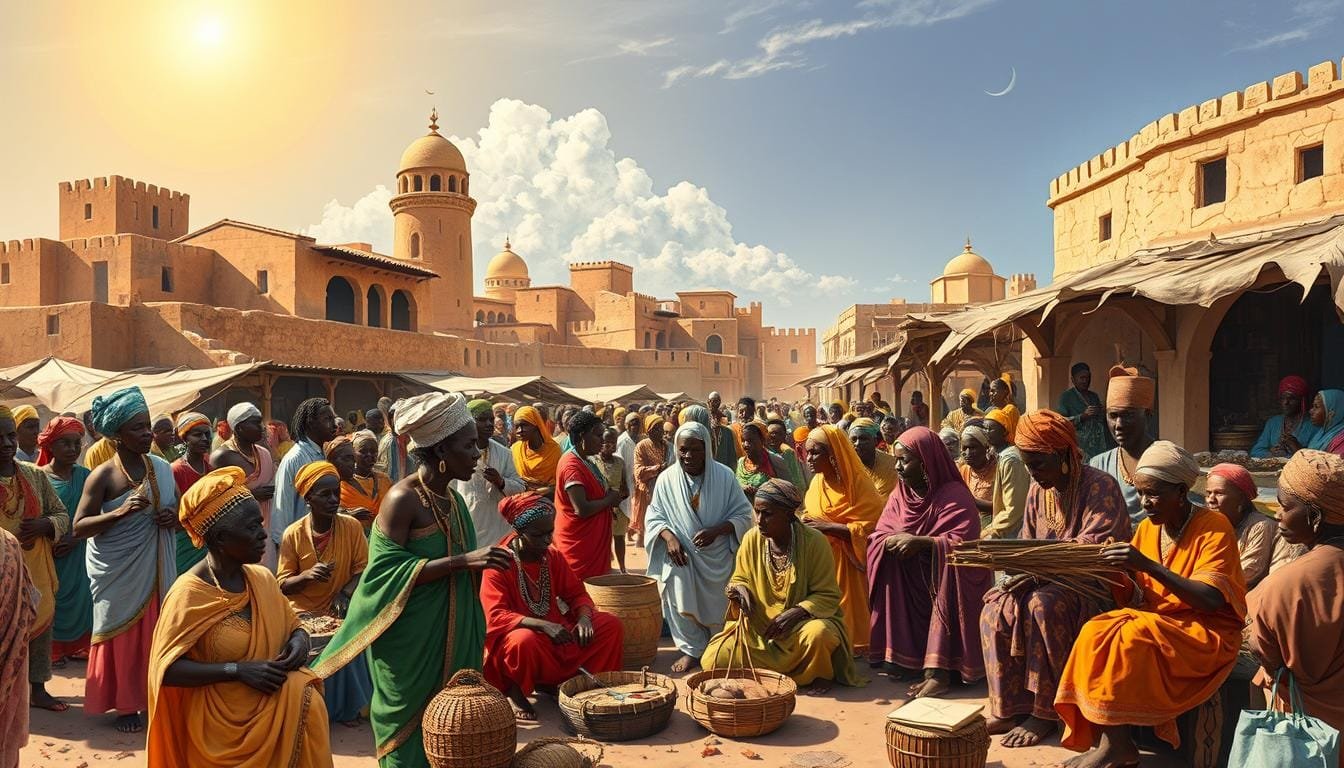The Mali Empire stood strong from the 13th to the 17th century. It was one of the largest empires in West Africa. Its lands reached across what is now Senegal, Mali, Burkina Faso, Niger, and Mauritania. The empire had a complex society. It was ruled by a monarch, with the Mansa at the heart of its governance. This ruler had power over a vast area of 1.2 million square kilometers.
Social ranks were clearly defined within the empire. The Mansa was on top, surrounded by court officials, religious leaders, and griots. Griots were storytellers. Education and religion were highly valued. They were woven into the rule and everyday life. This setup helped manage the empire’s diverse ethnic and linguistic groups, keeping the peace and unity.
Key Takeaways
- The Mali Empire spanned more than 1.2 million square kilometers at its height.
- Governance was centralized around the Mansa and his court officials.
- Islam played a crucial role in governance and daily affairs.
- Significant figures like Mansa Musa emerged from the Mali Empire.
- The social structure was heavily stratified by political and economic status.
The Origins of the Mali Empire and Foundation by Sundiata Keita
The Mali Empire started in the early 13th century. Sundiata Keita, a visionary leader, made the empire a key player in West Africa. Let’s explore the steps that led to the creation of this important empire.
Early History and Formation
The Mali Empire’s history is tied to its people. Born in 1217, Sundiata Keita united Malinké kingdoms. His win at the Battle of Kirina in 1235 against Sumanguru Kanté was crucial. This victory established the Mali Empire, letting Sundiata strengthen his rule and set up future success.
- 1235 CE: Sundiata Keita defeats Sumanguru Kanté at the Battle of Kirina.
- Sundiata uses this victory to unite surrounding Malinké kingdoms.
- The Manden Charter, often seen as the first bill of rights, is created. It promotes peace and education.
Consolidation of Small Kingdoms
After his victory, Sundiata worked to unite smaller kingdoms by the Upper Niger River. He aimed to bring unity to diverse groups. By bringing small Malinké states together under one government, the area became stable and saw economic growth.
Sundiata chose Niani as the empire’s capital, turning it into a key spot for politics, trade, and culture. With control over major trade routes, the empire used its gold and copper riches to grow. Sundiata’s leadership made the Mali Empire one of West Africa’s strongest states.
- Centralized government brought tribal leaders and merchants together.
- Capital city, Niani, turned into a hub for trade and culture.
- Control of trade routes boosted the economy, especially with gold and copper.
Economic and Cultural Prosperity
The Mali Empire flourished from the 13th to the 17th century. Its wealth came from controlling trade routes in West Africa. This control made Mali a powerhouse, enabling the trade of gold and salt, important products of the time.
The Role of Trade in the Mali Empire
Trade was a key to Mali’s economy. By dominating important trade routes, Mali could tax the goods that traveled through. Taxes were placed on gold and salt, very valuable items then.
Gold, in nuggets or dust, was freely traded. Salt was crucial for food preservation and was widely traded too.
The Importance of Timbuktu as a Learning Center
Timbuktu was more than a trade center. It was also a place of learning and culture. Mansa Musa, who went on a pilgrimage to Mecca in 1324, ruled at this time. He helped establish significant Islamic learning centers.
One of these was the famous University of Sankore. It attracted scholars and students globally, making Timbuktu a world-known knowledge and culture hub.
Contribution of Gold and Salt Resources
The Mali Empire thrived on its natural wealth. Gold and salt trades were major wealth sources. Besides these, cotton cloth played a role in the economy.
These trades, controlled and taxed by the empire, brought in steady revenue. This wealth allowed Mali to grow and prosper. It funded architectural developments and learning institutions, enhancing the empire’s grandeur.
| Resource | Contribution | Impact |
|---|---|---|
| Gold | Trade currency, wealth accumulation | Funded architectural and cultural projects, significant economic driver |
| Salt | Preservation of food, trade commodity | Essential for daily life and trade, heavily taxed for revenue |
| Timbuktu | Learning center, trade hub | Enhanced the empire’s intellectual and cultural reputation, attracted scholars and traders |
How was the New Empire of Mali Structured in Society
Looking into the social structure of the Mali Empire, we see a complex system. The top leader was the Mansa, holding ultimate power. His authority was strong but he relied on his court and nobles to run this vast empire.

The King’s family was key in administration, ensuring trust. Below them, court officials handled daily tasks and enforced laws. They were vital in putting the Mansa’s plans into action.
The divide between royals and non-royals in the ancient Malian hierarchy showed a merit-based progression. Though skilled people could rise, royal heritage meant a higher status. This structure ensured stable governance.
At the base were the common people, including farmers and traders. Their roles were crucial for the empire’s wealth. The economy thrived on free trade, thanks to resources like gold and salt.
To understand the social structure of the Mali Empire is to see how it stayed united and peaceful. The Mansa’s balance of power with local control allowed for growth and cultural integration.
| Hierarchy Level | Roles and Responsibilities |
|---|---|
| Mansa | Supreme ruler with ultimate authority; oversees all aspects of governance. |
| Royal Family | Holds high-ranking positions; ensures the continuity of power and stability. |
| Court Officials | Manages administrative tasks; implements policies and maintains order. |
| Common Citizens | Includes farmers, artisans, traders; the backbone of economic prosperity through trade. |
Leadership and Governance in the Empire
The Mali Empire’s governance centered around the Mansa leadership. They had political and spiritual power. This role let the Mansa tightly control the Empire’s vast areas.

The Role of the Mansa
The Mansa, or emperor, was the top leader of the Mali Empire’s governance. They looked after the empire’s management, upheld laws, and kept the people safe and prosperous. Sundiata Keita, who started the Mali Empire, showed how to lead with strength and smart diplomacy.
Power of Court Officials
Court officials had major power in the Mali Empire. They managed daily operations. They made sure Mansa’s orders were followed in the empire’s large territories. They dealt with finance, justice, and messaging, keeping the empire stable and organized.
Decentralization of Government
The Mali Empire favored a decentralized administration. Local leaders managed provinces and towns. This approach worked well for governing the Empire’s diverse and large territory. The Mansa leadership system worked well, even when the central power was weak. Local management helped keep the peace and gave provinces some independence.
This decentralized system let the Mali Empire include many ethnic groups and cultures. It made the empire stronger and left a lasting legacy.
It was Sundiata Keita’s visionary leadership that laid the foundation of a governance system deeply entrenched in decentralization, which has been a subject of extensive historical research even in modern times.
| Aspect | Detail |
|---|---|
| Role of the Mansa | Supreme leader, overseer of administration, military and diplomatic skills |
| Power of Court Officials | Management of daily operations, financial oversight, judicial responsibilities |
| Decentralization | Local governance by mayors and governors, maintained stability across diverse regions |
The Decline of the Mali Empire
In the late 14th century, the Mali Empire saw a major decline. By the 16th century, it had collapsed. The decline was mainly due to weak rulers and poor management of internal and external challenges.
As central power fell, court officials grew stronger. This led to more internal conflicts and fragmentation.

Neighboring states, like the rising Songhai Empire, constantly attacked Mali. Led by Sunni Ali Ber from 1464 to 1492, the Songhai took advantage of Mali’s weakened state to expand. Mali couldn’t withstand these continuous threats.
The Moroccan conquest in 1591 also played a big role in Mali’s decline. Moroccan forces invaded, disrupting trade and attracting European colonial interest in West Africa.
The cultural and economic highs of Mali’s golden era faded due to these issues. The fall in trade further pushed Mali towards collapse.
The decline of the Mali Empire shows how internal problems and external pressures are linked. Despite once thriving on strong governance and trade, the empire crumbled under these threats. It eventually broke into smaller areas.
## Key Events Timeline
| Year | Key Events |
|---|---|
| 1230 | Founding of the Mali Empire by Sundiata Keita |
| 1324 | Mansa Musa’s pilgrimage to Mecca |
| 16th Century | Decline of the Mali Empire |
| 1464 – 1492 | Reign of Sunni Ali Ber of the Songhai Empire |
| 1591 | Moroccan invasion of the Mali Empire |
| 1960 | Mali gained independence with Modibo Keita as president |
| 2015 | Mali signed a peace accord to end the conflict in the north |
The decline of the Mali Empire was complex, caused by many issues inside and out. This great empire’s fall is an important lesson. It shows the need for strong leadership and a stable economy.
Conclusion
Looking back at the Mali Empire helps us understand West African history better. It was established by Sundiata Keita and was a center of wealth and culture. This empire grew by bringing smaller kingdoms together. It became rich by trading gold and salt.
Mali was more than just wealthy. Places like Timbuktu became centers of learning. The empire was known for its vast trade networks. Leaders like Mansa Musa made it famous with their journeys and support of Islam, including building mosques and schools.
The Mali Empire faced challenges like political issues, attacks, and changing trade paths, but its influence stays with us. It had a strong army and advanced trade. Today, we still admire its buildings and scholarly work, showing its power in African history. Mali’s story teaches us about its influence on other empires and today’s world.
FAQ
What was the social structure of the Mali Empire like?
The Mali Empire was governed by a detailed social ranking. The ruler, known as the Mansa, topped this hierarchy. Below him were nobles, court officials, and religious figures, each with distinct duties. Common people made up the bottom tier, but everyone played a part in maintaining the empire’s order and stability.
Who was Sundiata Keita and what was his role in the Mali Empire?
Sundiata Keita founded the Mali Empire after a pivotal victory in 1235 CE. He unified the Malinké kingdoms along the Upper Niger River. Under his leadership, Niani became the empire’s heart, launching an era of prosperity in West Africa.
How did the Mali Empire benefit from trade?
The Mali Empire thrived on trade, controlling gold and salt routes across West Africa. This leverage brought great wealth and aided the empire’s growth, both economically and culturally.
Why was Timbuktu important in the Mali Empire?
Timbuktu was a beacon of learning and culture in the Mali Empire. Its acclaim peaked under Mansa Musa, with institutions like the University of Sankore drawing in international scholars and traders.
What role did gold and salt play in the Mali Empire?
Gold and salt trade was the backbone of the Mali Empire’s economy. Its strategic position enabled control over these trades, fueling the empire’s prosperity and influence.
How was society organized in the Mali Empire?
Mali’s society was structured in layers with the Mansa at its pinnacle. This structure flowed from nobles to commoners, defining everyone’s role and status within the empire.
What was the role of the Mansa in the Mali Empire?
The Mansa was the supreme leader of the Mali Empire. He held the highest authority, overseeing both governance and spiritual matters, with a team of officials for support.
What was the importance of court officials in the Mali Empire?
Court officials were pivotal in the Mali Empire. They managed its territories and ensured smooth governance, playing a critical role in the empire’s stability and success.
How did the decentralization of government work in the Mali Empire?
In the Mali Empire, power was distributed. Governors and mayors managed local affairs, enabling effective control and stability across its vast landscapes, even when central power waned.
What led to the decline of the Mali Empire?
The Mali Empire faced decline due to weak rulership, internal conflicts, and outside threats. Loss of central control, rivalries, and challenges from the Songhay Empire and Morocco were key factors.
What is the historical significance of the Mali Empire?
The Mali Empire significantly influenced West Africa’s culture, trade, and government. Its rich legacy remains, celebrated for its architectural and educational contributions, especially in Timbuktu.
